Tanchjim One (DSP)
A ‘Futurefi’ IEM at a bargain price
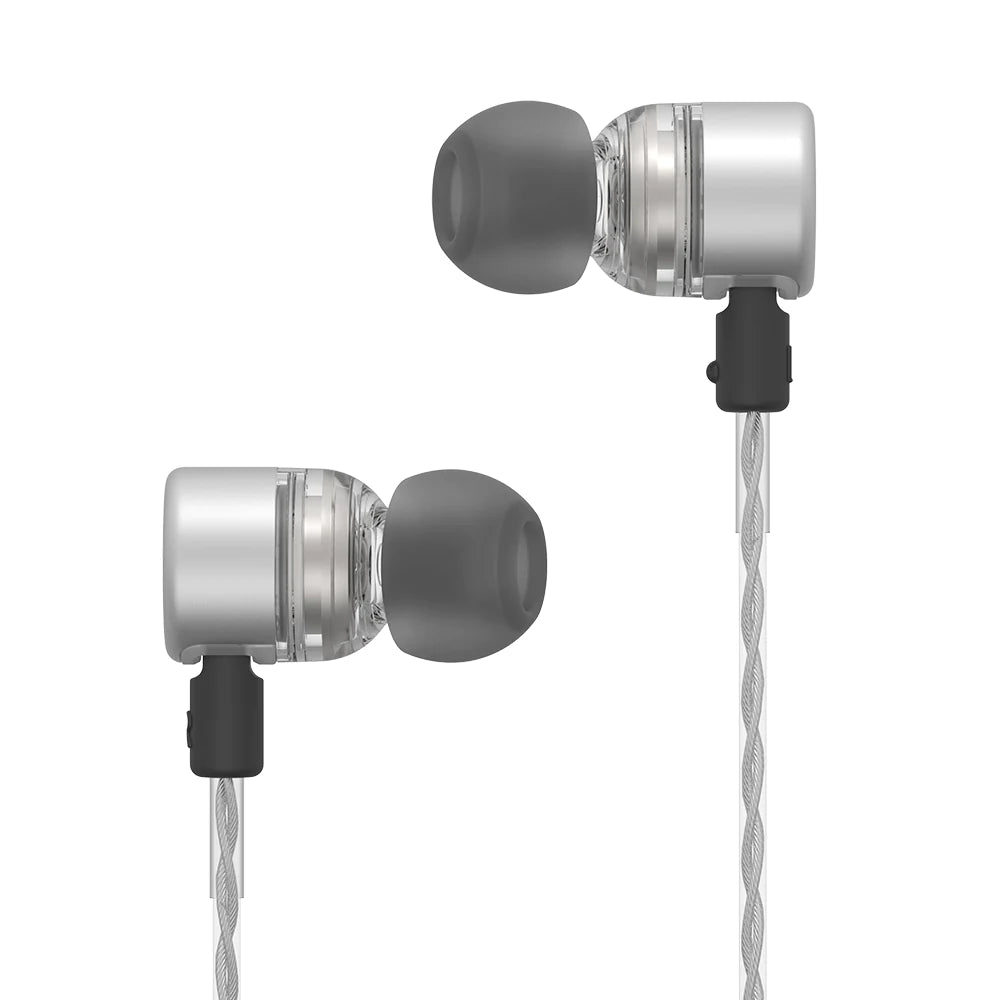
This is one of the most pragmatic devices I have bought in the past few years. It is effectively a 2:1 IEM for less than $30, by ‘default’ the Tanchjim One DSP has an excellent sound signature which for the price I would not complain about but then once you open up the App (Android only I am afraid) you have a series of very well specified alternative EQ based ‘profiles’, effectively giving you lots of variety without needing to get fully into the number within the PEQ filters provided.
And then if you feel like you don’t need DSP with the Tanchjim One (which to be honest you don’t as it has an excellent tuning by default), you can even use the Tanchjim One Cable with other IEM’s to change their sound signatures to your liking using the ‘magic’ powers of EQ.
Note: I purchased the Tanchjim One DSP from Linsoul for the purposes of this review. If you wish to do the same here is a non-affiliated (link)[https://www.linsoul.com/products/tanchjim-one?_pos=1&_psq=Tanchjim+one+dsp&_ss=e&_v=1.0&variant=44011373756633]
So is the Tanchjim One DSP the IEM for you, read on to find out …
What’s in the box
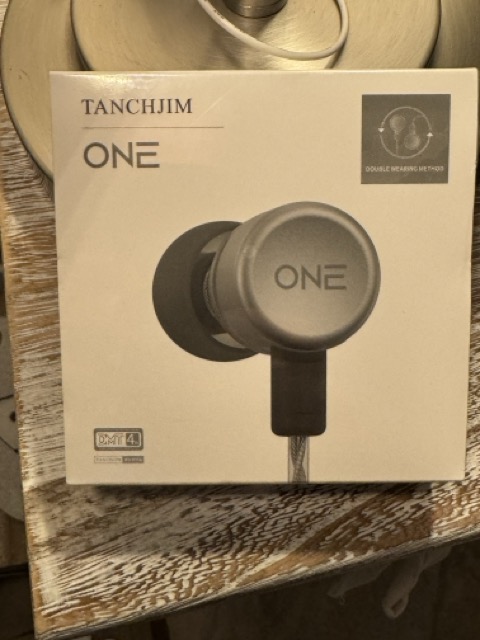
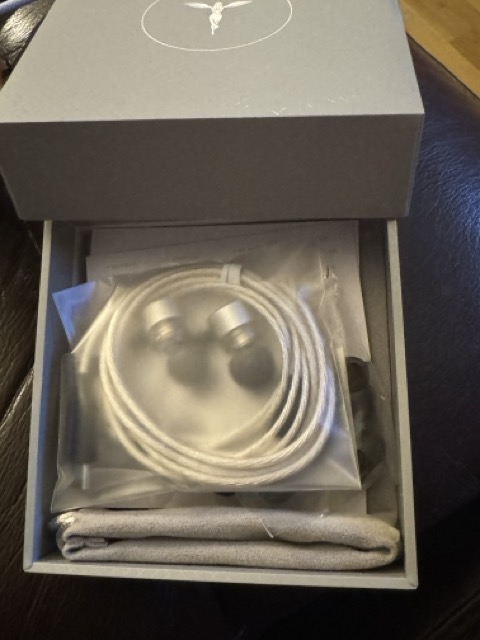
Upon unboxing, the Tanchjim One DSP Edition reveals an array of thoughtfully selected accessories.

These include a plush “velvet” bag, the ‘DSP’ cable and two sets of finely crafted tips encompassing a total of seven pairs. The inclusion of the manual and warranty rounds off the essentials, neatly presented.
Design and Build Quality
The design and build quality of the Tanchjim One Shell is good for this price range but while the cable has amazing technology inside it is not the best quality cable, I imagine Tanchjim will improve the quality and feel of the cable but use and extend upon the technology within the usb-c connector.
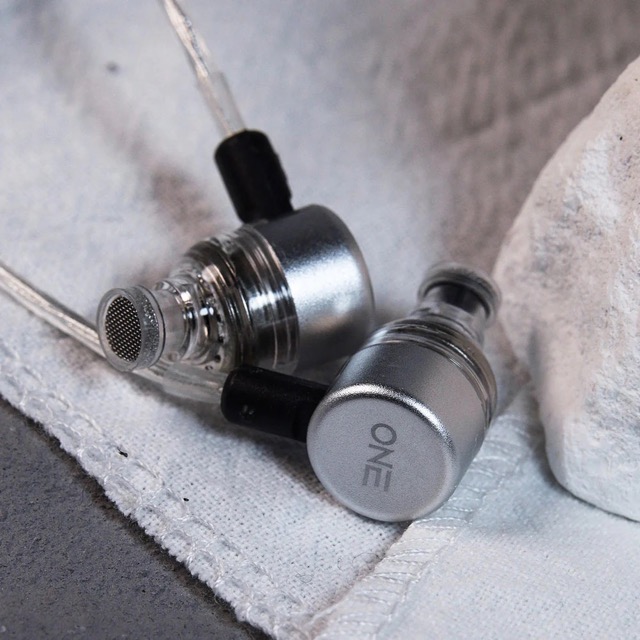
The minimalist design ethos is evident in the metal faceplate, clearly displaying the brand name, while the transparent plastic offers a glimpse into the heart of the device – the 10mm Dynamic Driver.
Remarkably, all of this is offered at a price point under $30 USD, highlighting Tanchjim’s commitment to affordability without compromising on quality. Compared to the Tanchjim Zero, the One boasts an increased percentage of metal in the shell compared to earlier models, detachable cables, and a comfortable fit.
Here is a quick video to show how nice the IEM and where you can see the angle of the nozzle:
Comfort and Fit
Comfort and fit have been significantly improved in the Tanchjim One DSP Edition. Gone are the sharp edges of the Zero, replaced with a more rounded and ear-friendly design. This change ensures a comfortable fit, allowing for prolonged listening sessions without discomfort. I liked the slight angled nozzle and the flexibility of wearing the cable either hanging down or wrapped around your ear give the One those options that allow people to find the best fit and comfort for them.
If you do decide to use the cable around your ears (IEM style) make sure to swap the Left / Right IEM’s as you are effectively wearing them ‘upside down’ - see the picture below:
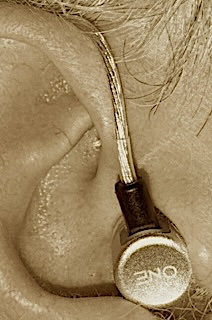
Sound Quality
In terms of initial sound impressions, the Tanchjim One DSP Edition offers a surprising auditory journey especially for those unused to EQ and DSP. The DSP cable provides the ability to a new dimension to the sound, for example a more pronounced sub-bass and even a three-dimensional soundstage that adds depth by changing the EQ profile.
Note: For these sound impressions below - I used the ‘Popular’ DSP present - which aligns the One close to the Harman target as you will see in the measurement section later in the review.
Bass
Since the ‘popular’ preset is close to the harman target there is a good deep bass and sub-bass with the upper-bass
recessed. Subjectively I did feel the sub-bass wasn’t as clean as IEM’s like the Truthear Zero Red and as you will
see later in the measurements there is a slight sub-bass rollooff but that is more to do with the number of Dynamic
drivers within the Truthear Zero Red, but compared to similar priced IEM’s this
has a bass performance that is more than acceptable.
Mids
The Mid were excellent especially when using this ‘Popular’ EQ filter really allowing the vocals to shine and providing excellent tonality with everything I played. If you were a ‘midrange’ fan I would suggest using the ‘Musical’ present.
Treble
While the treble was good with this EQ setting I did think this where the limitation of the 5 available PEQ filters is found a bit wanting (that the EQ presets like ‘Popular’ are made from), I would have like maybe 10 PEQ filters to tweak the treble a little more. I imagine in the next few years we will get similar usb-c ‘DSP cables’ but with a large number of filters.
Soundstage and Imaging
With the ‘Popular’ present the intimate soundstage is complemented by excellent imaging, tight and controlled bass, a clean and crispy mid-range, and smooth, airy treble. This performance, especially considering the price point, is nothing short of remarkable.
Tanchjim Mobile App and EQ
The real ‘futurefi’ aspect of this IEM is how well the implementation of the Tanchjim works when saving the EQ settings to the cable.
For those wondering why bother “can’t you just EQ on your Smartphone, PC or Mac”. In my opinion, there are many advantages when saving a ’tuning’ to an IEM cable:
-
Single EQ across devices
Once saved to the device, that profile is then available across all your devices, so while I initially tuned the Tanchjim One DSP on my Android Smartphone, I actually used it extensively across all my devices including an iPhone 15 Pro Max (due to Apples switch over to usb-c this works great) and my Macbook Pro. -
Tuning alternative IEM’s with the cable
Another key advantage is you can actually use the cable on other IEM’s, simpling changing the profile to your preference -
Providing a “system-wide” EQ on IOS
If you use various music apps on IOS (as I do), you will know there is no system-wide EQ. While some music apps have some EQ while others do not have any, so listening to a cable with ‘built-in’ is a huge advantage.
Android
To give people a feel for the simplistity and capabilities of the Mobile App I took a few screenshot to show how easy it is change EQ profiles.
So first the App recognizes the One is connected:
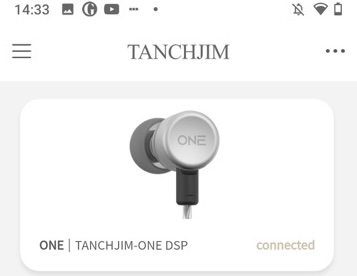
The clicking on the IEM in the menu you get the list of profiles:
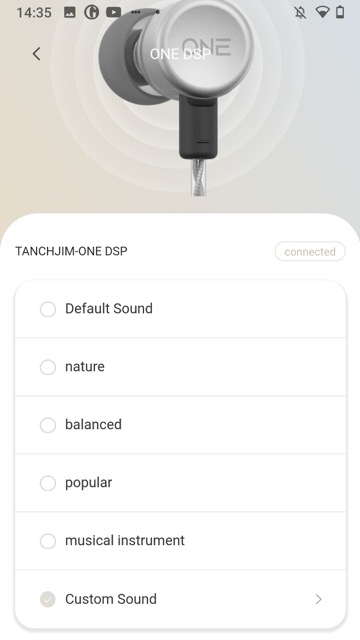
I mainly used ‘Popular’ but as you will see in the measurements section all these profiles provide excellent and interesting alternative tunings.
Once a EQ profile is picked you can then click the ‘Custom Sound’ option at the end of the list of Profiles and then
further tweak the profile:
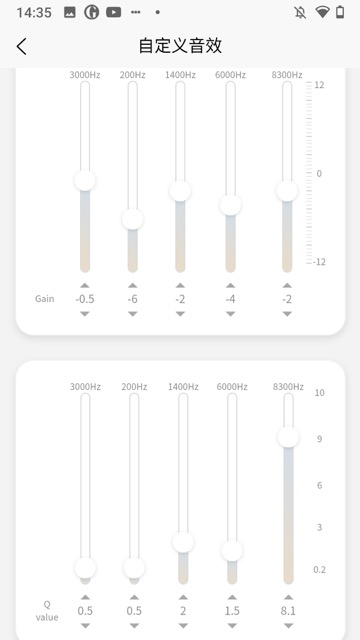 You change the Gain on the upper set of 5 sliders and the Q values on the bottom set of sliders.
You change the Gain on the upper set of 5 sliders and the Q values on the bottom set of sliders.
I would love to see this screen be extended with 10 or more ‘filters’ but the 5 available are an excellent start.
Comparison with other PEQ based Apps
In the last few months I have been using the PEQ features of many audio products, so here are a few comparisons:
-
Qudelik 5K
If you are a total PEQ ’nerd’ get a Qudelik 5K as their Mobile App (both Android and IOS) has fantastic control over the PEQ and many other features to play with but IMO it is too complicated for most users and while I still use my 5K I feel other devices have overtaken it in audio quality. -
FiiO Control
FiiO application is rapidly improving (both on IOS and Android) but still has many UI quirks and does not offer the simplicity of the presets that Tanchjim offer. -
Moondrop Free DSP
While the FreeDSP cable definitely a set-up over the Tanchjim usb-c cable, there application is at the time of writing this review a complete mess with confusing UI, odd limitations (e.g. can’t set PEQ for sub-bass or Q values can only be whole numbers). I do like their cable but at the moment it is incredible complicated to get the right settings for your own IEM, though Moondrop does offer some presets what you get with those presets is not obviously from their Application. -
Soundcore
Even though it’s only for Soundcore Headphones and IEM’s their Mobile app does at least try to expose enough EQ power (not PEQ though) to compensate for their default ‘bass heavy’ tuning while still offering lots of presents for their headphones and TWS and its one of the best mobile Apps for TWS devices.
Overall, I feel the Tanchjim application is the right balance for most people of simplicity and power, here are my comparisons with other EQ / PEQ applications that ‘save’ their PEQ to their associated device
IOS and macOS
Due to some current limitations with iOS, you cannot ‘save’ settings to usb-c devices, so I therefore mainly used the Android version of the Tanchjim Mobile app to switch sound profiles and experiment with the 5-band PEQ offered with the One DSP. I believe this limitation will be removed soon as it is a legacy limitation from the time when Apple ‘controlled’ the ’lightning’ cable connectors.
On a Mac this is how the DAC is exposed when the usb-c cable is connected:
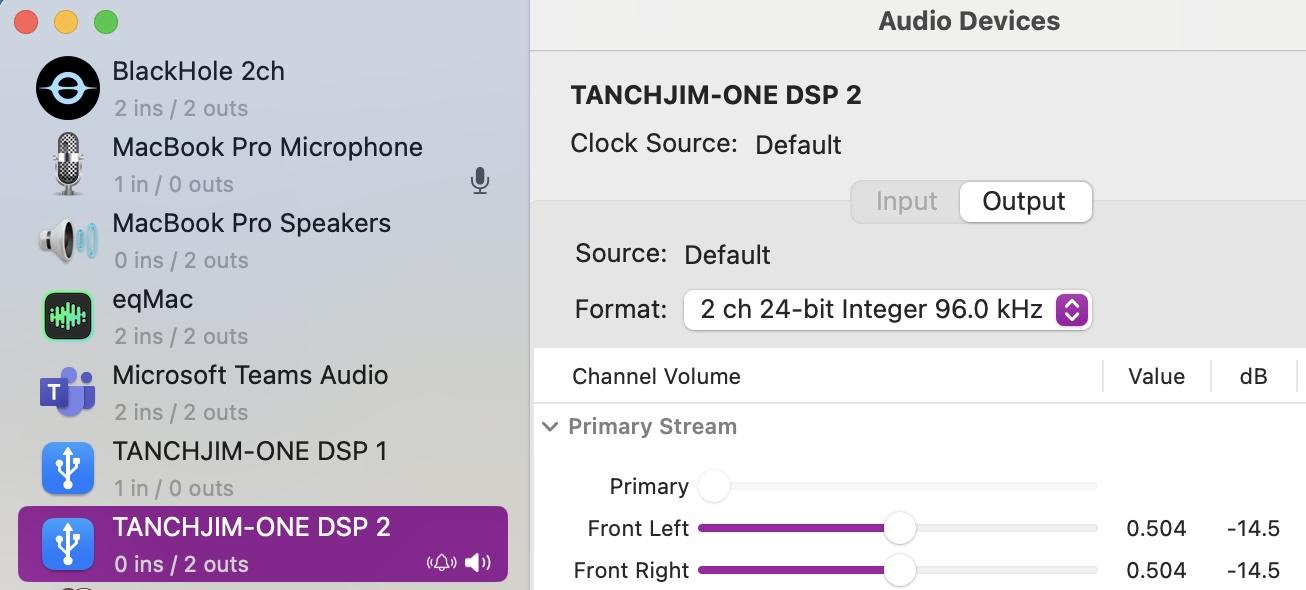 Though there is no application currently available to configure the EQ filters.
Though there is no application currently available to configure the EQ filters.
Specifications and Measurements
Specifications
The important specifications:
| Drivers | 1 x DD (10mm LCP) |
| Sensitivity | 126 dB/Vrms @1Khz |
| Frequency response | 7-45Khz |
| THD | <0.062% @1Khz |
| Driver | 10mm dynamic driver |
| Impedance | 16Ω士10% @1Khz |
| Cable | 1.25M 3.5MM 0.78PIN |
Measurements
Note: For those interested I have published these measurements to the PragmaticAudio Squig [website] (/iems/?share=Harman_Adjusted_Target,Tanchjim_One_Stock,Tanchjim_One_D_Popular,Tanchjim_One_D_Musical,Tanchjim_One_D_Default,Tanchjim_One_D_Nature,Tanchjim_One_D_Balanced)
Frequency Response:
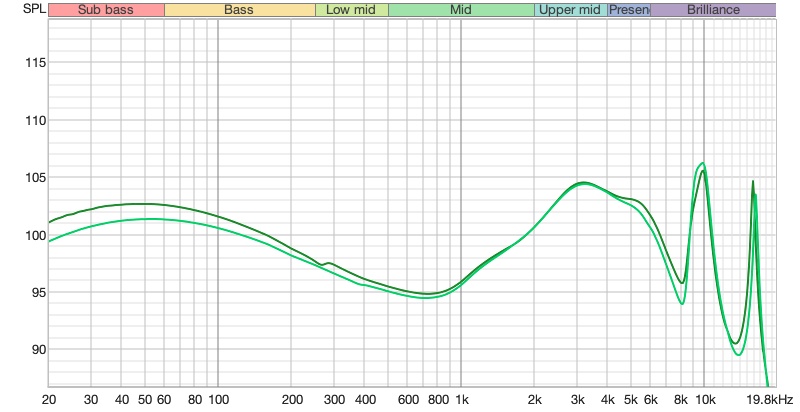 There is a slight channel imbalance of 1db but this affects the bass region, so you will not hear an imbalance.
There is a slight channel imbalance of 1db but this affects the bass region, so you will not hear an imbalance.
DSP ‘Presets’ Measured:
I hope this graphs shows the power of the One DSP, each “preset” offers a great alternative frequency response. IMO, this makes the Tanchjim One DSP an amazing first IEM for someone getting into the hobby.
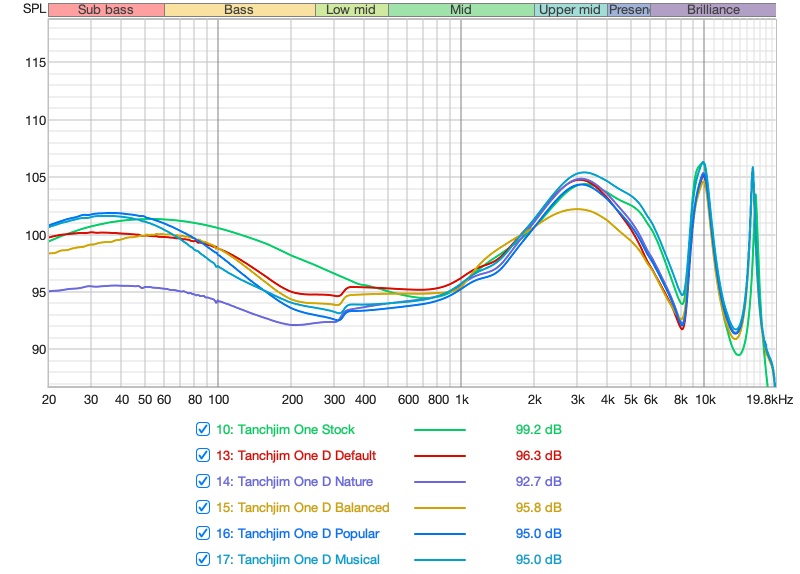
This is the most interesting set of measurements for the Tanchjim One DSP:
- Stock Tuning ( using a non-DSP enabled cable)
This provides a nice ‘warm’ sound for those who like a ‘fuller’ bass, so if that is your preference I suggest swapping the cable with a different IEM and possible tune that other IEM with DSP to your preference - Default This is the default DSP settings without selecting a given profile. Its mostly pretty balanced with a slightly fuller midrange.
- Nature
This tuning is the most dramatic, effectively reducing the bass to allow the midrange and treble to shine. - Balanced
This as the name implies is a balanced sound - less bass and less treble more midrange focused for a balanced sound - Popular
This is the one I mainly used it has that ‘harman target’ curve (as you will see below). - Musical
This one is probably the nearest to my own personal preference as its like the Popular one but with a little less bass and treble. Basically 1/2 way between the Popular (i.e. Harman) and the Balanced ( i.e. Flat ) sound.
Distortion Measurements:
With the DSP is enabled the 2nd harmonic is quiet high but less than the 1% audible range for ’even’ harmonics.
The 3rd harmonic does creep up in the bass region when using the Popular (i.e. Harman ‘bass’) profile. But again
the 3rd harmonic is below the 0.1% audibility range of ‘odd’ harmonics.
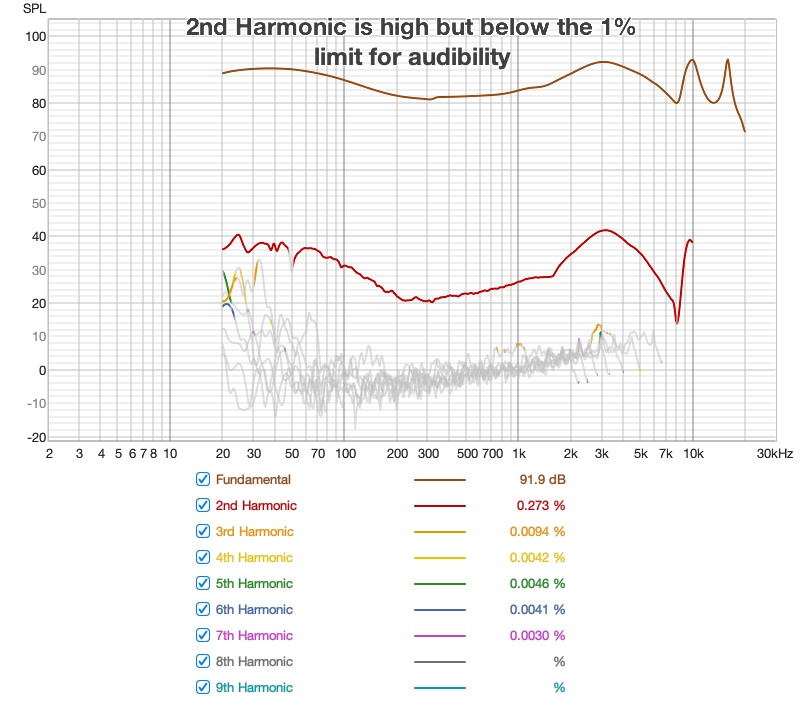
The 3rd harmonic while still in-audible distortions is no doubt a side effect of using single Dynamic Driver. Therefore, if Tanchjim used the same technology with more say a double DD (like the Truthear Zero Red) or a DD+BA hybrid the amount of work the single DD has to do would be limited and the distortion levels would go down. But since its below audible thresholds it is not really a concern especially at this price point.
Comparison to the Harman Target:
As you can see from this graph the “balanced” profile is an excellent match for the Harman IE target with a slight
roll off in the sub-bass frequencies:
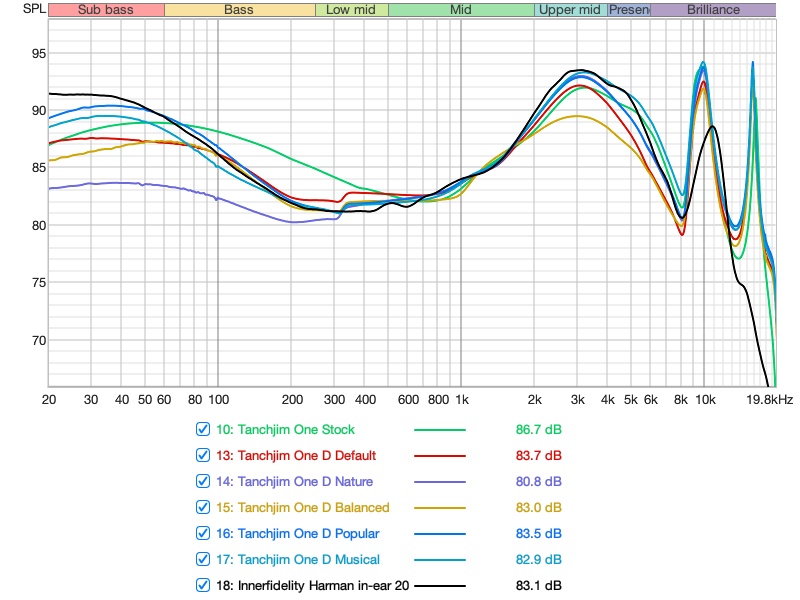
Note: I would like to see a 10 band PEQ in the next generation of these devices as I feel that would help with tweaks in the treble frequency range.
Rating
While I gave the One DSP a sound/measurement rating 4 due to the level of distortion, but I still felt this is a tremendous pragmatic device, so I gave an overall pragmatic rating of 5 stars as I feel it is a glimpse of the future. I feel Tanchjim will ultimately release more expensive models with a better quality cable, more drivers and an upgraded DSP with a 10 band PEQ but for less than $30 the One DSP is a glimpse of the future.
Conclusion
The Tanchjim One DSP is a fantastic IEM for its price, it has a great ‘default’ tuning but with the additional ‘superpowers’ of DSP ‘profiles’ within the Tanchjim Android app you get everything you need to enjoy your music no matter what your audio ‘preferences’. It is a high recommended IEM for those who enjoy their music and like to investigate different sound profiles.